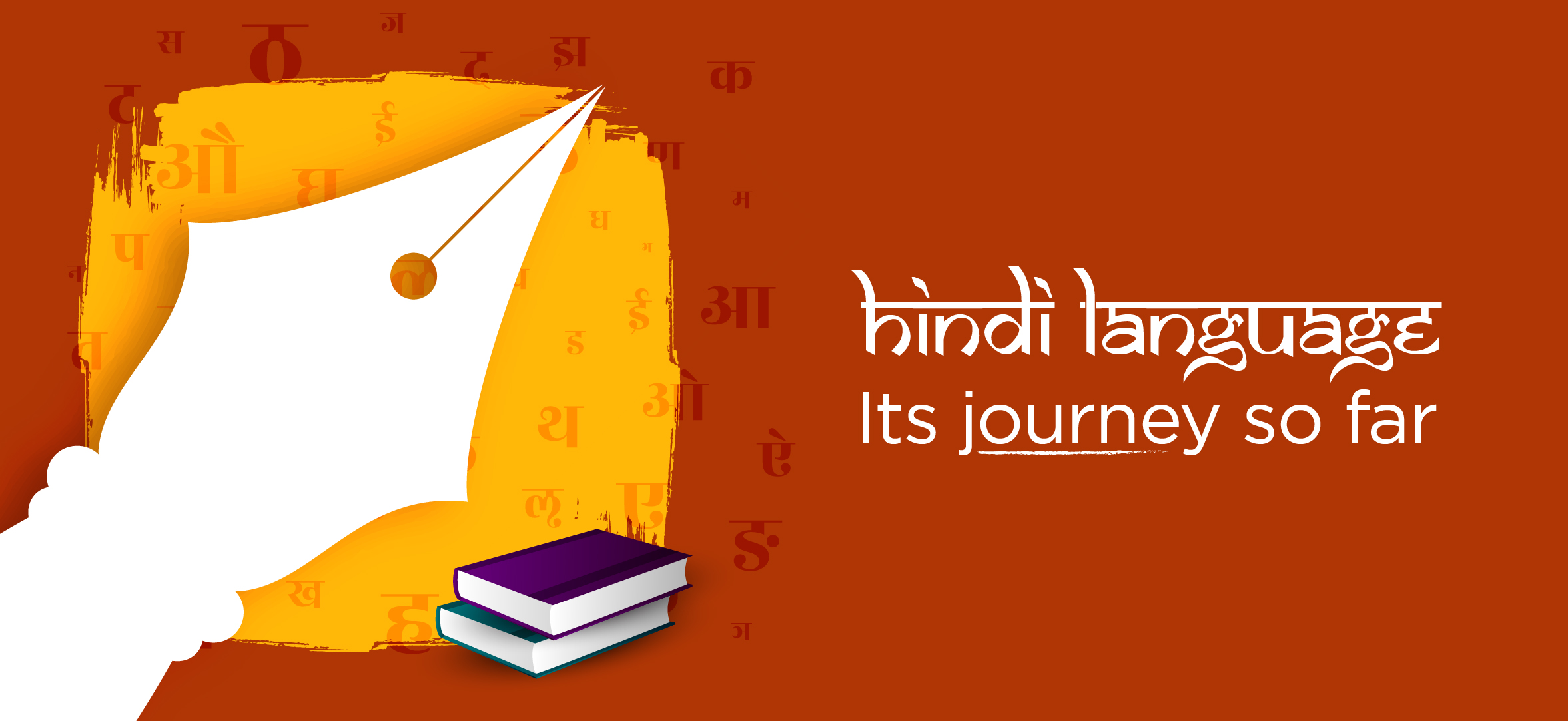Hindi Language: Its Journey So Far
Blogs Home
- 10 Jan 2023

Hindi is the official language of the Republic of India and is spoken by most of the country's 1.3 billion people. It is an Indo-Aryan language related to other languages such as Sanskrit and Punjabi and is written in the Devanagari script.
Hindi has a long and fascinating history that is closely tied to the development of the Indian subcontinent and the people who have lived there. The earliest known examples of Hindi date back to the 10th century and are found in the Khari Boli dialect, which is the basis for Modern Standard Hindi.
Over the centuries, Hindi has undergone several significant changes, both in its spoken and written forms. One of the most important of these was the development of a standardized form of the language during the British colonial period, which helped to promote literacy and make Hindi more widely understood.
History of Hindi Language
Hindi is a language that is spoken by millions of people all over the world, particularly in India and Nepal. It is the official language of the Indian government and is also recognized as one of the 22 official languages of India. Hindi is also one of the six languages that are officially recognized by the United Nations.
The history of Hindi can be divided into three main periods:
The Pre-Modern period (10th to 18th centuries)
During this time, Hindi was primarily spoken in the northern and central parts of India and was heavily influenced by Sanskrit and other regional languages. The earliest known examples of Hindi are found in the Khari Boli dialect, which was spoken in the Delhi region and surrounding areas.
The Modern period (19th to mid-20th centuries)
During the colonial period, Hindi was standardized and made the official language of India by the British. This helped to promote literacy and made the language more widely understood. In addition to the standardization of the language, the Hindi script was also reformed and a standardized form of Devanagari was adopted.
The Post-Independence period (mid-20th century to present)
After India gained independence from the British in 1947, Hindi was made the official language of the country. Since then, it has continued to evolve and develop, with a number of regional dialects and variations emerging. Today, Hindi is spoken by the majority of the Indian population and is one of the most widely spoken languages in the world.
In addition to its long and rich history, Hindi is also an important language in terms of its cultural significance. It is the language of Hinduism, one of the world's oldest and largest religions, and is used in a wide range of cultural and artistic expressions, including literature, film, and music.
Facts about Hindi Language
Hindi is an Indo-Aryan language spoken by over 260 million people in India and around the world. It is the official language of the Indian states of Uttar Pradesh, Uttarakhand, Chhattisgarh, and Madhya Pradesh.
Here are some facts about Hindi language:
- Hindi is a part of the Indo-Aryan language family, which is a subgroup of the Indo-Iranian branch of the Indo-European language family.
- Hindi is the fourth most spoken language in the world, after Mandarin Chinese, Spanish, and English.
- Hindi is written in the Devanagari script, which is a syllabic script that was developed in the 7th century CE. The script is named after the town of Devanagar, which is located in the present-day state of Gujarat in India.
- The earliest known texts written in Hindi date back to the 11th century CE. These texts are religious in nature and are written in a form of Sanskrit known as Old Hindi or Hindavi.
- Modern Hindi was developed during the British Raj in India, when the British government established Hindi as an official language along with English.
- Hindi has a rich literary tradition, with many notable works of poetry, fiction, and non-fiction being written in the language. Some examples of famous Hindi poetry include the works of Kabir, a 15th-century mystic poet whose verses continue to be popular to this day. Another famous poet from the same era is Mirabai, a Rajput princess and devotee of Lord Krishna whose poems are considered some of the finest examples of Bhakti poetry. In more recent times, the works of poets such as Harivansh Rai Bachchan, Sumitranandan Pant, and Mahadevi Varma have been widely acclaimed.
- Hindi is spoken in a variety of dialects, with the standard dialect being known as Khariboli. Other notable dialects include Braj Bhasha, Bhojpuri, and Awadhi.
- Hindi has a number of loanwords from various languages, including Persian, Arabic, and English. Persian loanwords in Hindi can be found in many different areas of the language, including literature, government, and law. Some examples of Persian loanwords in Hindi include "sharab" (alcohol), "darbar" (court), and "mazaar" (mausoleum).
Arabic loanwords in Hindi can also be found in many different areas of the language, including religion, culture, and education. Some examples of Arabic loanwords in Hindi include "namaz" (prayer), : quran" (holy book of Islam), and "maulvi" (Islamic teacher).
English loanwords in Hindi have become increasingly common in recent years, especially in the areas of technology, business, and media. Some examples of English loanwords in Hindi include "computer" ( ) "mobile" (
) "mobile" ( ) and "email" (
) and "email" ( )
) - Hindi has a rich oral tradition, with many folk tales, songs, and stories being passed down from generation to generation.
- Hindi, as one of the major languages spoken in India, has certainly influenced the development of other languages in the region. For example, many Indian languages have borrowed words from Hindi, as well as grammatical structures and literary conventions.
For example, Hindi and Urdu are two languages that are commonly spoken in India and Pakistan respectively, they share a lot of common vocabulary and grammar but written in different scripts, Hindi uses Devanagari script while Urdu uses Perso-Arabic script.
Similarly, many of the languages spoken in the northeastern states of India, such as Assamese, Bengali, and Oriya, have been influenced by Hindi. The influence of Hindi can also be seen in the development of new languages and dialects in India, as well as in the fusion of different languages and dialects to form new hybrids. - Hindi is an SOV (subject-object-verb) language, which means that the verb comes at the end of the sentence.
- Hindi has a complex grammatical structure, with nouns and verbs being inflected to show gender, number, and case.
- Hindi is a tonal language, with words having different meanings depending on the tone in which they are pronounced.
Significance of Hindi Language
There are several reasons why Hindi is such a significant language, not just in India but also globally. Here are some of the reasons why Hindi is important:
Hindi is the dominant language of the Indian subcontinent: With over 500 million speakers, Hindi is the dominant language of the Indian subcontinent, followed by Bengali and Telugu. It is the language that is most commonly used for communication between different regions and states in India.
Hindi is the official language of the Indian government: As mentioned earlier, Hindi is the official language of the Indian government and is used for all official communication and documentation. This means that if you want to work in the government sector or interact with the government in any way, you need to be proficient in Hindi.
Hindi is a medium of instruction in schools: Hindi is the medium of instruction in schools in several states of India, particularly in the northern and central regions. Therefore, if you want to pursue higher education in India, it is essential to have a good command of Hindi.
Hindi is used in the media: Hindi is the language that is used in the Indian media, be it television, radio, or print. Therefore, if you want to stay updated with the latest news and happenings in India, you need to have a good understanding of Hindi.
Hindi is a language of literature and culture: Hindi has a rich tradition of literature and culture that dates back several centuries. There are several famous Hindi poets and authors whose works are still widely read and admired today. Hindi is also the language of Bollywood, the largest film industry in the world, which means that if you want to understand and appreciate Indian cinema, you need to have a good command of Hindi.
Hindi is a language of business: With India being one of the fastest-growing economies in the world, Hindi is an important language for business and commerce. Many international companies and organizations have a presence in India, and therefore, it is essential for them to have employees who are proficient in Hindi.
Hindi is a language of diplomacy: As mentioned earlier, Hindi is one of the six languages that are officially recognized by the United Nations. This means that it is a language of diplomacy and is used in international communication and negotiations.
Conclusion
Hindi is a language that is spoken by millions of people all over the world and is an important language for various reasons. It is the dominant language of the Indian subcontinent, the official language of the Indian government, a medium of instruction in schools, a language of the media, literature, and culture, a language of business, and a language of diplomacy.
Despite its widespread use and cultural importance, Hindi has faced a number of challenges throughout its history. One of the biggest challenges has been the issue of language politics, with various groups advocating for the promotion of their own regional languages at the expense of Hindi.
In recent years, however, there has been a greater recognition of the importance of Hindi as a national language and efforts have been made to promote its use and preserve its rich cultural heritage. Today, Hindi continues to thrive and evolve, with millions of people around the world speaking and learning the language.

Aditi Saini
After pursuing Master's in Political Science from Indraprastha College for Women, Delhi University, she engrossed herself in Content Writing. Apart from being honest and a kind person, she is a good learner with the motto of "Live and let live".
Blogs Home



